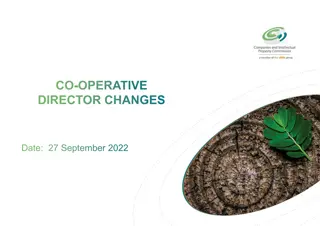Understanding Alterations in Genitourinary Function: An Overview
The genitourinary system comprises the urinary and reproductive organs, with the kidneys, ureters, bladder, and urethra playing crucial roles. Maintaining proper function involves factors like renal blood flow, glomerular filtration, tubular function, and urine flow. Nephrons are the functional units of the kidneys, with biological variances presenting challenges in early life stages. Pediatric differences in kidney function and bladder capacity highlight age-related variations. The genitourinary system also helps in maintaining fluid and electrolyte balance, hormonal regulation, and vitamin D metabolism. Various diagnostic tests are available to assess genitourinary health, such as urinalysis, ultrasound, VCUG, and more.
Download Presentation

Please find below an Image/Link to download the presentation.
The content on the website is provided AS IS for your information and personal use only. It may not be sold, licensed, or shared on other websites without obtaining consent from the author. Download presentation by click this link. If you encounter any issues during the download, it is possible that the publisher has removed the file from their server.
E N D
Presentation Transcript
Alteration in Genitourinary function Lecture 8 1
Anatomy and physiology The genitourinary is made up of the urinary and reproductive organs. The urinary system of the kidneys, ureters, bladder and urethra. Normal function requires the following: Unimpaired renal blood flow. Adequate glomerular filtration. Normal Tubular function. Un obstructed urine flow. The functional unit of the kidney is nephron. 2
Nephrons 4
Biological Variances All nephrons are present at birth Kidneys and tubular system mature throughout childhood reaching full maturity during adolescence. During first two years of life kidney function is less efficient. 5
Pediatric Differences Kidney begins to reach adult functioning about 1 year of age Infants cannot concentrate urine as efficiently as older children and adults. Urine output: Infant 2ml/kg/hr Children 0.5ml/kg/hr. Adolescent 40-80 ml/hr 6
Bladder Bladder capacity increases with age 20 to 50 ml at birth 700 ml in adulthood 7
Review Genitourinary System Maintain fluid & electrolyte balance through glomerular filtration, tubular reabsorption, and secretion Hormonal functions Produces renin in glomerulus regulates BP Produces Erythropoietin stimulates RBC production in bone marrow Metabolized Vitamin D to active form which is important in calcium metabolism 8
Urine Whaley & Wong Application of urine collection bag. 9
Diagnostic Tests Urinalysis Ultrasound VCUG Voiding cysto urethrogram IVP Intravenous pyelogram Cystoscopy CT Scan Renal Biopsy 10
VCUG test 11
IVP test 12
Renal Biopsy 13
Cystoscopy Invasive surgical procedure Visualizes bladder and ureter placement. 14
CT Scan 15
Urinalysis Protein Leukocytes Red blood cells Casts Specific Gravity Urine Culture for bacteria 16
Treatment Modalities Urinary diversion Stents Drainage tubes Intermittent catheterization Watch for latex allergies Pharmacological management Antibiotics Anticholinergic for bladder spasm 17
Urinary tract infection (UTI)? A urinary tract infection is an infection of the bladder (cystitis) or kidney(s) (pyelonephritis). Cystitis is considerably more common than the more severe and more serious pyelonephritis. Classification of UTI: Urethritis: inflammation of the urethra Cystitis: inflammation of the bladder Ureteritis: inflammation of the ureters Pyelonephritis: inflammation of the upper urinary tract and kidneys 19
Causes urinary tract infections in children Escherichia coli accounts for 80% of all cases.2 Anatomical factors stasis of urine due to incomplete bladder emptying. Vesicoureteric reflux (the backward flow of urine from the bladder into the ureters during voiding) Physical factors The presence of urinary catheters allows ascending infection of the urinary tract. Tight clothing or pants,. Bubble baths and shampoos can irritate the ureters in both boys and girls and increase the risk of developing infection.3 Chemical factors An adequate fluid intake promotes flushing of the bladder, thereby reducing the number of organisms in the urine. Urine is slightly acidic and most pathogens favour an alkaline medium. Certain beverages such as cranberry juice are thought to lower urinary pH. 20
Sign and Symptom non-specific Failure to thrive Vomiting and diarrhoea Jaundice Pyrexia Irritability Strong smell from urine Persistent nappy rash Frequent/infrequent voiding Screaming on voiding Specific Frequency Urgency Dysuria Small volumes of urine passed Lower abdominal or flank pain Enuresis in a previously continent child Fever Haematuria Vomiting Smell from urine 21
Management 1. Elimination of the current infection 2. Identification of contributing factors in order to reduce recurrence 3. Prevention of systematic spread of the infection and the preservation of renal function. 22
Can UTIs in children be prevented 1. Hygiene: Wipe females from front to back during diaper changes or after using the toilet in older girls. With uncircumcised males, mild and gentle traction of the foreskin helps to expose the urethral opening. Most boys are able to fully retract the foreskin by 4 years of age. 2. Complete bladder emptying: 3. Avoid the carbonated drinks, high amounts of citrus, caffeine (sodas), and chocolate. 4. Avoid bubble baths 5. Prophylactic antibiotics: Daily low-dose antibiotics under a doctor's supervision may be used in children with recurrent UTIs. 23
Interventions Antibiotic therapy for 7 to 10 days E-coli most common organism 85% Amoxicillin or Cefazol or Bactrim or Septra Increase fluid intake Cranberry juice Sitz bath / tub bath Acetaminophen for pain Teach proper cleansing 24
Enuresis Unable to control bladder function although reached an age at which control of voiding is expected Nocturnal Enuresis Bed wetting 25
Pathophys and etiology of Enuresis Control of urination is r/t maturation of CNS By 5 years, most are aware of bladder fullness and can control voiding Daytime first with nighttime dryness later Girls seems to master before boys Children with primary enuresis may have delayed maturations of this part of CNS. They are not able to sense bladder fullness and do not awaken to void 26
Nsg Dx: Enuresis low self-esteem r/t bedwetting or urinary incontinence Impaired social interaction r/t bedwetting or urinary incontinence Ineffective family coping r/t negative social response 27
Interventions Pharmacological intervention: Desmopressin synthetic vasopressin acts by reducing urine production and increasing water retention and concentration Tofranil: anticholinrgic effect FDA approval for treatment of enuresis Side effect may be dry mouth and constipation Some CNS: anxiety or confusion Need to be weaned off 28
Treatment Enuresis Diet control Reduce fluids in evening Control sugar intake Bladder training Praise and reward Behavioral chart to keep track of dry nights Alarm system 29
Obstructive uropathy Obstructive uropathy is a condition in which the flow of urine is blocked, causing it to back up and injury one or both kidneys. 30
Common causes of obstructive uropathy include: Bladder stones Kidney stones Benign prostatic hyperplasia (enlarged prostate) Bladder or ureteral cancer Colon cancer Cervical cancer Uterine cancer Any cancer that spreads Problems with the nerves that supply the bladder 32
Symptoms may include: Mild to severe pain in the middle of the body (flank pain). Fever Weight gain or swelling (edema) Urge to urinate often Decrease in the force of urine stream Dribbling of urine Not feeling as if the bladder is emptied Decreased amount of urine Blood in urine 33
Treatment 1. Stents or drains placed in the ureter or in a part of the kidney called the renal pelvis may provide short-term relief of symptoms. 2. Nephrostomy tubes, which drain urine from the kidneys through the back, may be used to bypass the obstruction. 3. A Foley catheter, placed through the urethra into the bladder, may also be helpful. 34
Hypospadias Incomplete formation of the anterior urethral segment. 35
Hypospadias Incomplete formation of the anterior urethral segment Cordee downward curve of penis. Goal of surgery: to make urinary & sexual function as normal as possible and improve appearance of penis 36
Nsg Dx: Hypospadius Knowledge deficit (parental) r/t diagnosis, surgical correction, & post-op care Risk of infection r/t indwelling catheter Impaired physical mobility r/t surgical procedure of penis 37
Extrophy of Bladder Interrupted abdominal development in early fetal life produces an exposed bladder and urethra, pubic bone separation, and associated anal and genital abnormalities. 38
Extrophy of Bladder Occurs is 1 of 400,000 births Congenital malformation in which the lower portion of abdominal wall and anterior bladder wall fail to fuse during fetal development. 39
Clinical Manifestations Visible defect that reveals bladder mucosa and ureteral orifices through an open abdominal wall with constant drainage of urine. 40
Treatment Surgery within first hours of life to close the skin over the bladder and reconstruct the male urethra and penis. Urethral stents and suprapubic catheter to divert urine Further reconstructive surgery can be done between 18 months to 3 years of age 43
Goals of Treatment Preserve renal function: prevent infection Attain urinary control Re-constructive repair Sexual function 44
Long Term Complications Urinary incontinence Infection Body image Inadequate sexual function 45
Acute Renal Failure Sudden interruption of kidney function resulting from obstruction, reduced circulation, or disease of the renal tissue Results in retention of toxins, fluids, and end products of metabolism Usually reversible with medical treatment May progress to end stage renal disease, uremic syndrome, and death without treatment 46
Acute Renal Failure Causes Prerenal Hypovolemia, shock, blood loss, embolism, pooling of fluid r/t ascites or burns, cardiovascular disorders, sepsis Intrarenal Nephrotoxic agents, infections, ischemia and blockages, polycystic kidney disease Postrenal Stones, blood clots, urethral edema from invasive procedures 47
Acute Renal Failure Subjective symptoms Nausea Loss of appetite Headache Lethargy 48
Acute Renal Failure Objective symptoms vomiting disorientation, edema, Increase K+ decrease Na Increase BUN and creatinine Acidosis uremic breath hypertension caused by hypovolemia, anorexia sudden drop in UOP convulsions, coma changes in bowels 49
Acute Renal Failure Diagnostic tests BUN, creatinine, sodium, potassium. pH, bicarb. Hgb and Hct Urine studies US of kidneys KUB renal CT/MRI Retrograde pyloegram 50























